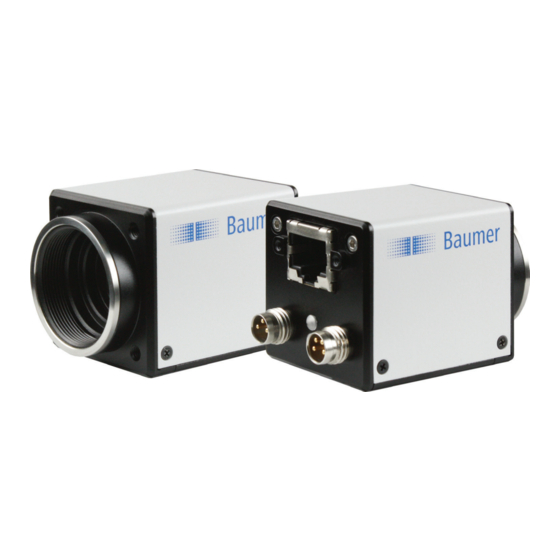Baumer EXG03c 사용자 설명서 - 페이지 28
{카테고리_이름} Baumer EXG03c에 대한 사용자 설명서을 온라인으로 검색하거나 PDF를 다운로드하세요. Baumer EXG03c 42 페이지. Gigabit ethernet
Baumer EXG03c에 대해서도 마찬가지입니다: 사용자 설명서 (42 페이지)

Figure 35 ▲
Operation of two camer-
as employing a Gigabit
Ethernet switch.
Data processing within
the switch is displayed
in the next two figures.
Figure 36 ►
Operation of two cam-
eras employing a
minimal inter packet
gap
(IPG).
Max. IPG:
On the Gigabit Ethernet
the max. IPG and the data
packet must not exceed 1
Gbit. Otherwise data pack-
ets can be lost.
Figure 37 ►
Operation of two camer-
as employing an optimal
inter packet gap (IPG).
28
5.3.1 Example 1: Multi Camera Operation – Minimal IPG
Setting the IPG to minimum means every image is transfered at maximum speed. Even
by using a frame rate of 1 fps this results in full load on the network. Such "bursts" can
lead to an overload of several network components and a loss of packets. This can occur,
especially when using several cameras.
In the case of two cameras sending images at the same time, this would theoretically oc-
cur at a transfer rate of 2 Gbits/sec. The switch has to buffer this data and transfer it at a
speed of 1 Gbit/sec afterwards. Depending on the internal buffer of the switch, this oper-
ates without any problems up to n cameras (n ≥ 1). More cameras would lead to a loss of
packets. These lost packets can however be saved by employing an appropriate resend
mechanism, but this leads to additional load on the network components�
5.3.2 Example 2: Multi Camera Operation – Optimal IPG
A better method is to increase the IPG to a size of
optimal IPG = packet size + 2 × minimal IPG
In this way both data packets can be transferred successively (zipper principle), and the
switch does not need to buffer the packets�
